Roseate Spoonbill
Ajaja ajaja
The only Spoonbill in the western hemisphere!
Advertisement
Roseate Spoonbill Scientific Classification
- Kingdom
- Animalia
- Phylum
- Chordata
- Class
- Aves
- Order
- Ciconiiformes
- Family
- Threskiornithidae
- Genus
- Ajaja
- Scientific Name
- Ajaja ajaja
Read our Complete Guide to Classification of Animals.
Roseate Spoonbill Conservation Status
Roseate Spoonbill Facts
- Prey
- Minnows, Shrimp, Insects
- Name Of Young
- Chick
- Group Behavior
- Flock
- Fun Fact
- The only Spoonbill in the western hemisphere!
- Estimated Population Size
- Sustainable
- Biggest Threat
- Water pollution
- Most Distinctive Feature
- A long, spatula-shaped bill
- Wingspan
- 110cm - 130cm (43in - 51in)
- Incubation Period
- 3 weeks
- Age Of Fledgling
- 1 month
- Habitat
- Shallow wetlands and mangrove swamps
- Predators
- Alligators, Coyotes, Humans
- Diet
- Omnivore
- Lifestyle
- Diurnal
- Common Name
- Roseate Spoonbill
- Number Of Species
- 1
- Location
- Gulf Coast, Central and South America
- Average Clutch Size
- 3
- Slogan
- The only Spoonbill in the western hemisphere!
- Group
- Bird
View all of the Roseate Spoonbill images!
Amazing Facts About Roseate Spoonbills
- Males court females by offering them nesting material.
- They get their pink coloring from their prey like flamingos.
- They were once hunted to the brink of extinction.
- Their origins go all the way back to 66 million years ago!
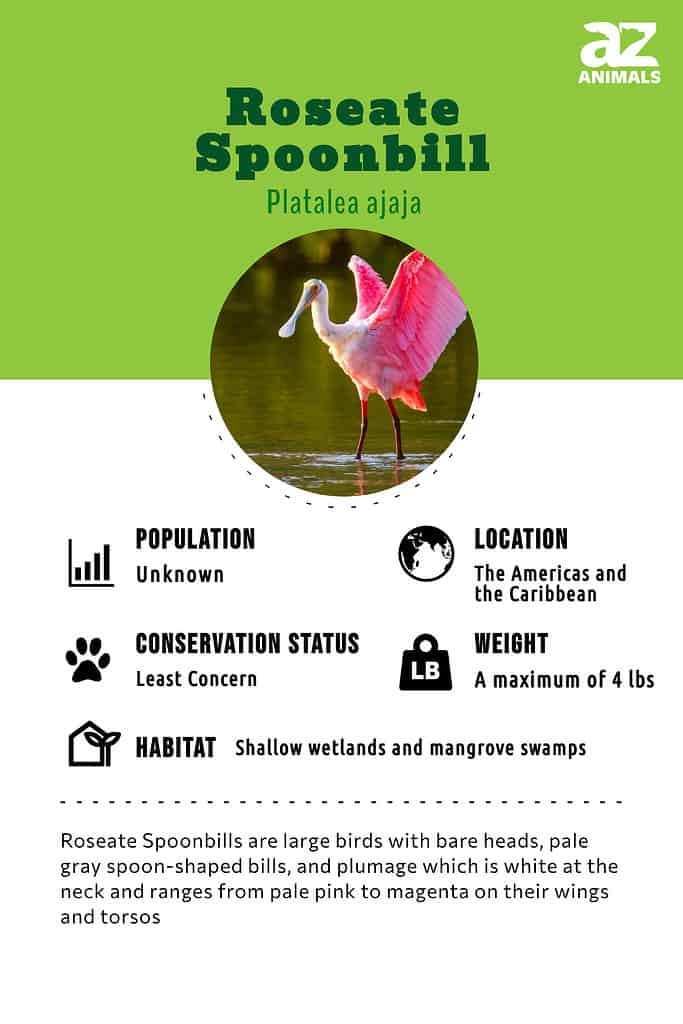
Classification and Evolution
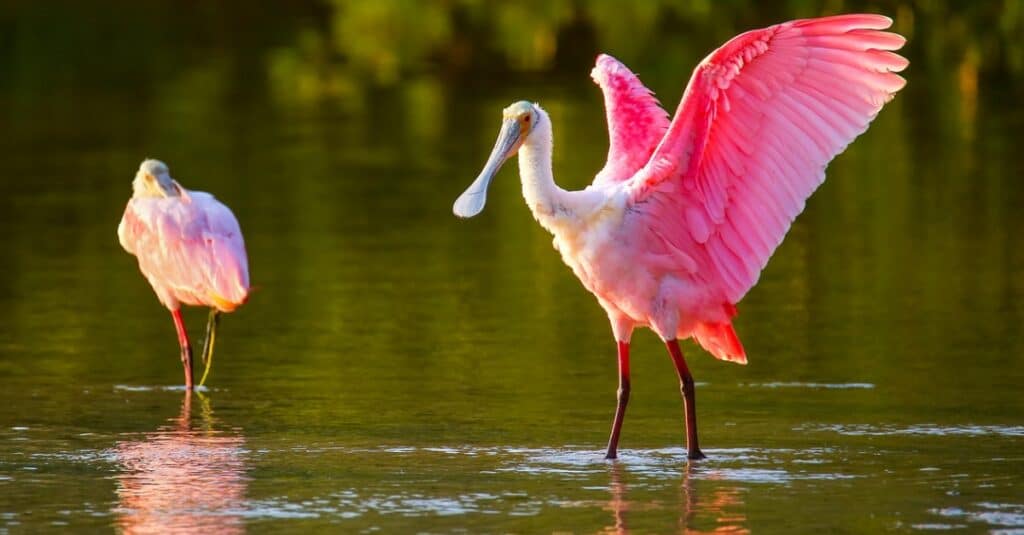
Roseate spoonbills are related to bitterns, hamerkops, herons, and ibises
©iStock.com/Donyanedomam
As a member of the genus Platalea, the roseate spoonbill belongs to a group of birds found all over the globe. The members of this collective are divided into six species. They share a large size and long limbs in common as well as a tolerance for both fresh and salty water (with a preference for the former). They can also be recognized by their lengthy, spoon-shaped bills.
The close relatives of the roseate spoonbill include:
- African spoonbill
- Black-faced spoonbill
- Eurasian spoonbill
- Royal spoonbill
- Yellow spoonbill
The genus itself comes under an even larger family of birds, the Threskiornithidae which contains ibises as well. As a result, roseate spoonbills are also related to the African sacred ibis, the crested ibis, and the scarlet ibis.
These birds are also Pelecaniformes and as a result are related to bitterns, hamerkops, herons, and shoebills. Their ancestors are believed to have emerged as the Cretaceous period was drawing to an end, about 66 million years ago.
Anatomy and Appearance
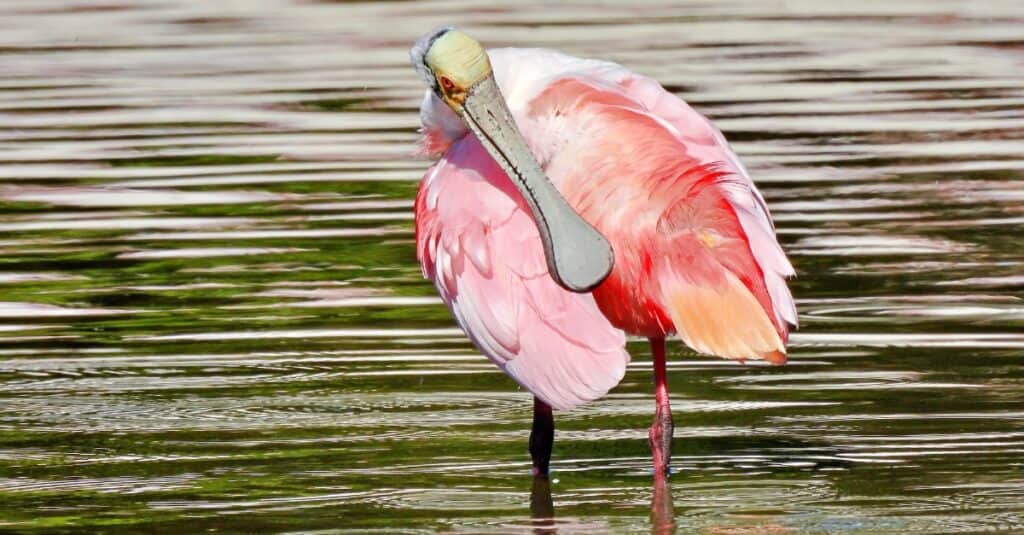
Roseate Spoonbills are capable of growing to almost 3 feet in height and weighing 4 pounds
©iStock.com/passion4nature
Roseate spoonbills can be recognized by their small bare green heads and red eyes, long pale gray spoon-shaped bills, and sinuous necks covered in white feathers, which extend to their backs. Their chests and wings may take on a pale pink which may deepen to a dark rose at the coverts. These wading birds also have lengthy dark red legs.
They are rather tall and are capable of growing to almost three feet in height (34 inches) and weighing as much as four pounds. They are capable of having a wingspan of 4 feet. There is little sexual dimorphism (i.e., gender-based differences) between the sexes.
Distribution and Habitat

The Roseate Spoonbill can be found wading in the swamps, mudflats, and wetlands of the Gulf Coast
©iStock.com/Canon_Bob
These large waders can be found on Mexico’s eastern and southeastern coasts, the southern coasts of Texas, Louisiana, Alabama, and the northern and western coasts of Florida. From spring to the middle of fall, roseate spoonbills live along the Gulf Coast where they spend their days searching for their favorite foods.
When breeding season arrives, they can be found in the Caribbean including the Cayman Islands, Cuba, Hispaniola, Jamaica, and Puerto Rico. During this season, they can also be found in South America including Argentina, Chile, and Uruguay. They have also been spotted in Georgia and are being found in South Carolina in increasing numbers.
Behavior and Lifestyle
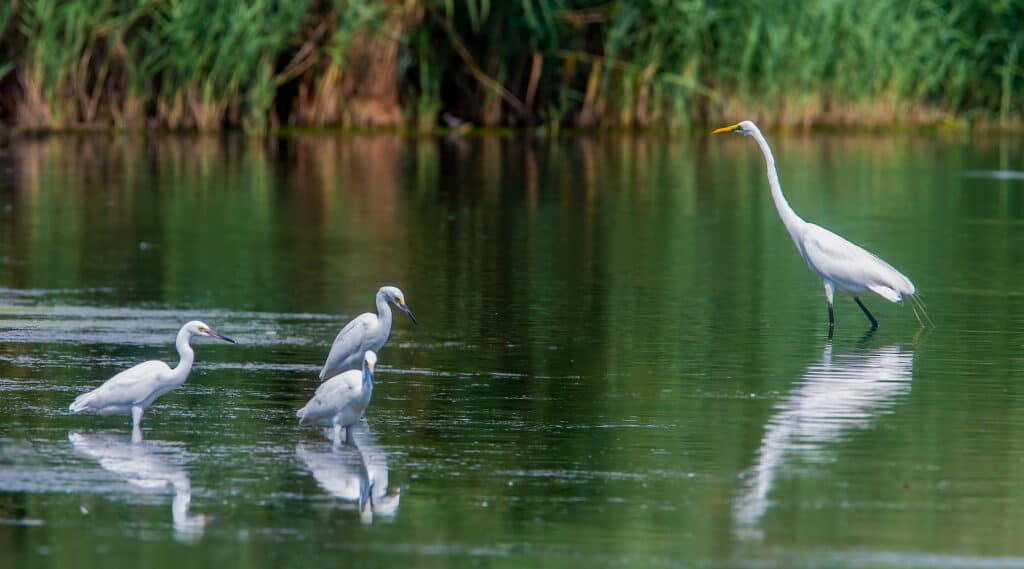
Roseate spoonbills share their feeding grounds with egrets, ibises, and herons which they are related to
©David W. Leindecker/Shutterstock.com
Social by nature, roseate spoonbills are quite content to hang around other members of their species. They spend most of their day searching for fresh crustaceans in coastal waters amongst other waders. Those avians include egrets, ibises, and herons which roseate spoonbills are also related to.
Roseate spoonbills tend to fly with their necks outstretched, like cranes and egrets. They maintain their fondness for each other’s company in flight.
Generally, these waders prefer to build their living quarters in trees hanging above the water close to other birds such as storks. Alternatively, they may also build them on the ground on islets with gulls, herons, and terns also sharing the same slice of real estate.
However, for the most part, researchers have found that the lifestyles and habits of these birds known for their beautiful plumage are somewhat shrouded in mystery.
Reproduction and Life Cycles
By the time they’re four months old, roseate spoonbills are just about ready to become parents and bring new life into the world. That said, they usually don’t set out to have their own hatchlings until much later – when they’re about 36 years old. Mating season starts at the beginning of spring and lasts through the season.
The male of the species declares his intention to court by offering the female material for building a nest. There are also performances involving clapping and dancing. With the sticks presented to her, the female roseate spoonbill puts her nest-building skills to good use. The result is a sturdy construction in which she deposits her eggs which may be as many as five. Both parents share incubation duties and the new hatchlings arrive after about three weeks.
Roseate spoonbill chicks get to feed on regurgitated nutritious fare provided by both parents and soon start to attempt to clamber their way out of the nest. In about a month and half their flight feathers sprout, and at two months, they are ready to take to the skies.
Diet and Prey
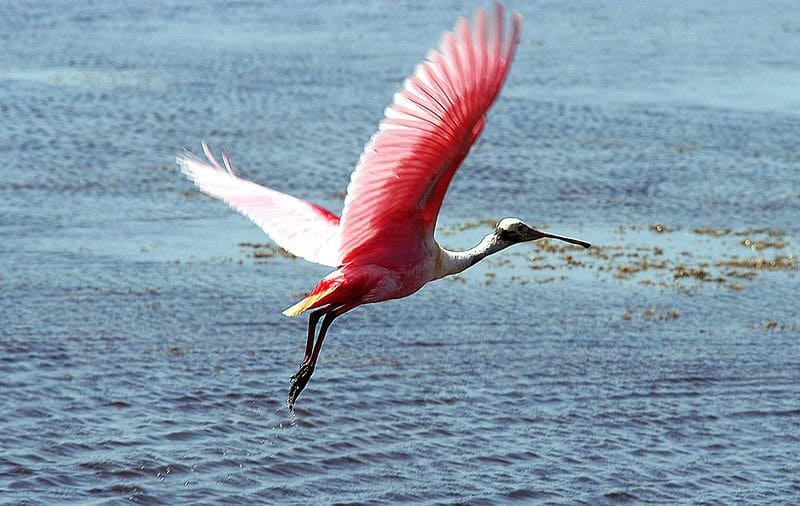
Roseate spoonbills are omnivores and get their coloring from their food
©Solipsist – Public Domain
Roseate spoonbills enjoy an omnivorous lifestyle although their diet mostly consists of crustaceans, fish, and small invertebrates. Their dietary habits are actually believed to be responsible for their unique coloring which is obtained from the shrimp they eat. Scientists believe the pigment which turns their plumage pink is created by the algae which these crustaceans gobble on a regular basis, with the end result being a wader with plumage which may range from delicate pink to magenta.
Meal times take place in the early mornings and evenings and are a communal affair. The large birds can be seen advancing through shallow water, moving those spoon-shaped bills from side to side in search of a tasty morsel.
Predators and Threats

Coyotes’ are fond of roseate spoonbills’ eggs and are known to pilfer them from their nests
©Jim Cumming/Shutterstock.com
Life in the wild is filled with peril for a young roseate spoonbill and enemies come in many forms for a young hatchling. They may be terrestrial in the form of fearsome fire ants in search of unattended chicks, or coyotes or foxes prowling the neighborhood in search of freshly laid eggs. Threats may also be aerial too, in the form of a golden-beaked bald eagle interested in fresh meaty fare rather than fish, for a change.
Interesting Facts and Features
In spite of being smaller in size and having a beak of a different shape and size, birdwatchers might occasionally mistake roseate spoonbills for flamingos. This especially holds true when they are flying. That said, they do share a few features in common with the larger avian. Such as their skill as capable flyers – an ability roseate spoonbills need to undertake their migratory winter trip to Central and South America. And a habit of flying with their necks outstretched. They also share the same diet of shrimp and the ability to alter their pigment through these crustaceans which themselves turn pink due to the pigment known as carotenoids produced by the algae the latter feed on.
Relationship with Humans
The story of the roseate spoonbill in North America is one of impressive resilience. In the19th-century milliners used their highly sought-after feathers extensively to decorate ladies’ hats. Their popularity in this regard placed them at risk as hunters descended on them in their numbers. The population of roseate spoonbills plummeted as a result of excessive hunting. However, they began to stage a comeback by the early 20th century with their population growing gradually around the Gulf Coast.
Conservation Status and Life Today
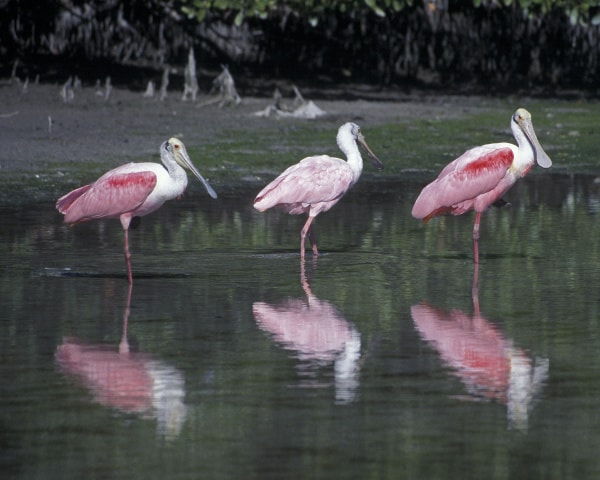
Roseate Spoonbills are threatened by pesticides and illegal shootings
©Lee Karney – Public Domain
The threat of hunters on a quest for their feathers is thankfully a thing of the past – especially since it has been made illegal. However roseate spoonbills must now contend with a different set of threats entirely. They include heightened volumes of freshwater from the Everglades which may mean a decrease in their favorite food items. Although they are protected by the U.S. Migratory Bird Treaty Act and by Florida’s Endangered and Threatened Species Rule which lists them as a State-designated Threatened species, these colorful birds still remain threatened by illegal hunting, a dwindling habitat, and pesticides. However, their conservation status remains Least Concern, at the present.
View all 114 animals that start with RRoseate Spoonbill FAQs (Frequently Asked Questions)
Are Roseate Spoonbills herbivores, carnivores, or omnivores?
Roseate Spoonbills are Omnivores, meaning they eat both plants and other animals.
What Kingdom do Roseate Spoonbills belong to?
Roseate Spoonbills belong to the Kingdom Animalia.
What phylum to Roseate Spoonbills belong to?
Roseate Spoonbills belong to the phylum Chordata.
What family do Roseate Spoonbills belong to?
Roseate Spoonbills belong to the family Threskiornithidae.
What order do Roseate Spoonbills belong to?
Roseate Spoonbills belong to the order Ciconiiformes.
What is the biggest threat to the Roseate Spoonbill?
The biggest threat to the Roseate Spoonbill is water pollution.
What is the Roseate Spoonbill's wingspan?
The Roseate Spoonbill has a wingspan of 110cm to 130cm (43in to 51in).
How to say Roseate Spoonbill in ...
Thank you for reading! Have some feedback for us? Contact the AZ Animals editorial team.
Sources
- David Burnie, Dorling Kindersley (2011) Animal, The Definitive Visual Guide To The World's Wildlife / Accessed April 13, 2011
- Tom Jackson, Lorenz Books (2007) The World Encyclopedia Of Animals / Accessed April 13, 2011
- David Burnie, Kingfisher (2011) The Kingfisher Animal Encyclopedia / Accessed April 13, 2011
- Richard Mackay, University of California Press (2009) The Atlas Of Endangered Species / Accessed April 13, 2011
- David Burnie, Dorling Kindersley (2008) Illustrated Encyclopedia Of Animals / Accessed April 13, 2011
- Dorling Kindersley (2006) Dorling Kindersley Encyclopedia Of Animals / Accessed April 13, 2011
- Christopher Perrins, Oxford University Press (2009) The Encyclopedia Of Birds / Accessed April 13, 2011
- Roseate Spoonbill Information / Accessed April 13, 2011
- Roseate Spoonbill Breeding / Accessed April 13, 2011
- About Roseate Spoonbills / Accessed April 13, 2011
- Roseate Spoonbill Conservation / Accessed April 13, 2011


















